To celebrate the fiftieth anniversary of the longest-running science-fiction show in the world, I’ll be taking weekly looks at some of my own personal favourite stories and arcs, from the old and new series, with a view to encapsulating the sublime, the clever and the fiendishly odd of the BBC’s Doctor Who.
Four to Doomsday originally aired in 1982.
Come along, children. Not in front of our hosts.
– the Doctor finally manages to strike the right tone with his companions
Four to Doomsday is an interesting story, if only because it’s so rarely discussed. The second story of a particular Doctor seems to set the tone for their era. William Hartnell’s second story, The Daleks, introduced the iconic pepperpots. Patrick Troughton’s second serial, The Highlanders, introduced the companion Jamie, who would remain with him for the rest of his tenure. Jon Pertwee’s second story, The Silurians, saw Barry Letts taking over the role of producer. Tom Baker’s second story, The Ark in Space, is one of the most memorable and definitive instances of horror in the history of the show. Colin Baker had the misfortune to have Attack of the Cybermen as his second story, an adventure that set the tone for his time in the TARDIS. Sylvester McCoy didn’t really develop until his second season, but he’s probably the exception that proves the rule.
Peter Davison’s Four to Doomsday, on the other hand, just sort of… is.
To be fair, there’s no major event to solidify the Fifth Doctor’s tenure here. The producer is still John Nathan Turner, who has been running the show for a year at this point. The show took a great deal of care in Tom Baker’s final year to set up a supporting cast for his successor, which is an approach with mixed results. The script for Four to Doomsday comes from Terence Dudley, a television veteran who worked on Terry Nation’s Survivors in the early seventies. He seemed quite unlikely to upset the apple cart.
As a result, Four to Doomsday doesn’t really define its era much. It’s a nice and functional piece of television that provides a four episode serial that slots between Castrovalva and Kinda, two stories that are – I’d argue – both more challenging and more rewarding. Indeed, it’s tempting to look at Four to Doomsday in terms of the role it played in the production schedule. Although it was the second story aired, it was the first story produced. This means that Four to Doomsday was the first time that Peter Davison played the Doctor opposite his companions, and the first time that the cast interacted.
In fairness, you could make a case that Four to Doomsday really exists to codify the TARDIS dynamic. After all, the Fifth Doctor had just regenerated in Castrovalva and Adric had spent most of that episode in the custody of the Master. So this was the first opportunity to see the whole gang together and watch them interact, dealing with what is – for Doctor Who – a relatively mundane and inoffensive sort of threat.
However, this raises one very obvious problem. The early Davison TARDIS dynamic doesn’t quite work. Quite frankly, Davison’s TARDIS is over-crowded with three companions. He finds his feet once he gets the number down to two, but the show struggles to really distribute the companion role across three supporting characters – which is ironic, since the role originated with three characters back in the first ever adventure.
There is, to be fair, a sense that the show realises this. In fact, the producers contemplated dumping Nyssa at the end of this story. Not only would that have been a little gruel after bringing her back in Logopolis after a guest appearance in The Keeper of Traken, but she is actually – on the evidence presented in this story – the best companion for Davison’s Doctor. In fact, Davison himself was shrewd enough to see this, and fought to keep Sarah Sutton on the show.
However, the last-minute change meant that Nyssa had to be written out of Kinda, so she… er, faints. While it’s not the most elegant of fixes, it does allow Kinda to demonstrate that the show can juggle two companions better than three. And the fact that this is obvious when you remove the companion who works best should be quite convincing. One struggling companion and one terrible companion are better alone than when paired up with the one functioning companion.
I should note that Nyssa is a very weird companion, at least to me. She’s the very embodiment of the “pass the test tube” companion. She’s a relatively introverted character who exists for the Doctor to talk to, and who exists to do the things that he tells her to do. She’s not the most dynamic or radical of characters. I am, as a rule, not specially fond of those generic companions. I tend to like a bit of character, a bit of presence. By all logic, I should prefer Tegan to Nyssa.
But Nyssa just works better with Peter Davison. Part of that is down to Sarah Sutton, who found her feet a lot quicker than Janet Fielding. Sutton isn’t asked to do very much, and she plays the role in an understated way that works well opposite Davison. You get the sense that she’s the only person in the TARDIS who is remotely interested in what the Fifth Doctor has to say, which is great. Because the Fifth Doctor has difficulty imposing himself on a situation, you need a companion like that.
You can see it in Four to Doomsday. Nyssa seems to be the one companion who quietly and completely has faith in the Fifth Doctor. Tegan is moaning about missing her flight or suggesting escaping to Earth; Adric doesn’t trust the Doctor more than this creepy green frog-man. Nyssa, on the other hand, rather quietly and with considerable dignity holds her ground. It almost gets her killed as she is hypnotised and walked into a death trap, but we’ll accept that being a companion has a learning curve.
There’s a sense that the Fifth Doctor has an obvious affection for her. While Adric and Tegan seem to need to be goaded or manipulated into doing what they’re told, Nyssa brings out the tender side of the Fifth Doctor. “They were going to kill me,” she tells him. “Yes, the devils,” he responds. It’s a corny line, but Davison delivers it remarkably well. Since Davison’s Doctor is going to spend so much time being the universe’s whipping boy, it’s very important to get these small tender moments.
Indeed, Nyssa even proves herself remarkably competent too boot. For all that she fills the stereotypical companion role, she gets to be ahead of the Doctor at certain points in the plot. She knows more about what’s going on than he does when she asks to borrow his pencil and his sonic screwdriver. Given she’s already proven she can fly the TARDIS, Nyssa seems to be doing quite well by all measures of companion aptitude. (Indeed, she sort of reminds me of Martha, another technically exceptional companion who doesn’t get enough character development. The difference is that Martha was featured when development was expected.)
However, if Nyssa works, it’s obvious that the other two companions haven’t found their feet yet. In hindsight, it’s easy to point to Adric as the companion who won’t work. I want to argue that it wasn’t as obvious here… but it’s pretty obvious here. Tegan is a problematic character at this point in her development, but Adric is already broken. In Castrovalva, he was separated from the TARDIS when the show clarified the roles the Tegan and Nyssa would take on the show, so he’s starting with a disadvantage.
Unfortunately, it gets worse. Adric has a reputation for switching sides. It’s not entirely deserved. Mostly, he’s fairly bad at pretending to switch sides. However, Four to Doomsday has Adric actually switching sides. He collaborates with a fascist dictator. Of course, there’s a wealth of stuff that he doesn’t know about the Monarch, but there’s no way to justify his betrayal based on what he actually knew. Four to Doomsday seems to tease the possibility of disagreement between this TARDIS crew. That’s a compelling dramatic hook, but it only works if it doesn’t rely on one character being an idiot.
Trying to sway Adric, the Monarch states that he plans “to come to the aid of the Earthlings. To save them from themselves. They’re not as intelligent as you. They war amongst themselves. They make more weapons than food and two thirds of them are starving. It is all a problem of the flesh time.” That’s debatable enough, but it’s really hard to accept Adric siding with the guy who apparently wants to turn all the people on Earth into robots. You could argue that Adric doesn’t believe that the Monarch would force the change, but then he’s have to believe that Earth people would readily agree to become robots and bow down to Monarch’s will.
It’s a very tenuous position at best, but Adric looks increasingly stupid when the episode immediately clarifies that the whole “benign dictatorship” thing is actually the soothing lie to cover Monarch’s real plans. We immediately cut to the revelation that the Monarch plans to harvest Earth’s silicon. And how, you ask? “In the Mobiliary there is a deadly poison. The deadliest in the known universe. The Urbankans secreted it in a gland. It causes organic matter to shrink in on itself. One trillionth of a gram would reduce you to the size of a grain of salt. With this he will conquer Earth.”
Again, we’re in the realm of things Adric doesn’t know, but things that still make Adric look stupid. When Adric betrays Nyssa to Monarch, he then proceeds to order her body turned to ash that will be used to fertilise his flowers. Just in case you didn’t get the subtlety of a power-mad genocidal dictator. Of course, all of this is incidental. Regardless of the stuff that we know which Adric doesn’t, the disagreement between Adric and Nyssa is over whether Monarch imposing himself as dictator is a good thing. The way the show works, we know Adric is wrong. Sadly, the fact that Monarch is an ugly green monster is only further proof.
Also, just in case you didn’t get the subtext, there’s a handy Ancient Greek character to make the argument to the audience. “In a civilised world, there is no substitute for democracy,” Bigon explains. Of course, Four to Doomsday glosses over the fact that Bigon’s democracy would exclude women from voting and included slavery, but – then again – the story does feature Greek gladiators, so what are you going to do about it? (Also dodgy: the show’s grasp of physics.)
You’d imagine that this sort of crap would get Adric booted out of the TARDIS, or at least make the place damn uncomfortable for everybody. Of course, that would pre-suppose that the show could support character development and interaction. To be fair, Four to Doomsday is trying. It gives the cast a point to disagree on, even if it’s simplistic. Tegan has a plausible character motivation, and at least some of Adric’s flaws are explicitly intended to be treated as such. The problem is that the show isn’t yet able to deal with any of this sort of character-related stuff.
I find the best way to approach the early Peter Davison episodes is to assume that a lot of character interaction happened off-screen, written by Russell T. Davies. The Fifth Doctor telling Tegan that her beloved aunt is dead and tenderly promising to take her home? That scene isn’t in any televised episode, but I infer its existence. Nyssa dealing with the loss of not only her father, but everybody she ever knew? It has to have happened, logically, so I imagine it’s like that scene with the Second Doctor and Victoria. The Fifth Doctor telling Adric to straighten up and fly right? Okay, even my imagination can’t get past Matthew Waterhouse’s lack of talent in a way that gets this to work.
The thing is, the show has the ingredients to make this cast dynamic and drama work. It just doesn’t know how to strike the proper tone. So Adric is suddenly a sexist douchebag, because Matthew Waterhouse lacks any dramatic ability. “That’s the trouble with women,” he states. “Mindless, impatient and bossy.” It’s the kind of line that would be troublesome coming from Jon Pertwee in The Time Warrior. Giving it to Matthew Waterhouse is… ill-advised.
When Nyssa asks him to help out with something, he tells her, “You know I’m no good with my hands.” It’s a line that any teenage boy would probably immediately regret saying to Sarah Sutton. Smutty joking aside, the show wants to acknowledge there are things that Adric isn’t good at (social interaction and physical stuff), but it can’t quite get that across. Based on what the script is awkwardly trying to do, why should be getting teenage Gregory House in the TARDIS, which is much better than what we actually ended up with.
And then there’s Tegan. Tegan’s problematic here, because she doesn’t want to be in the TARDIS. Like the three companions, this seems to hark back to the early days of the show. However, she seems incredibly demanding about it. She literally never shuts up about her damn job. That’s understandable, but this is a time machine. Tegan knows it’s a time machine. The TARDIS can get her to Earth fifteen minutes early for her first shift whether it’s today, tomorrow or the next day.
Again, the show is trying to suggest that Tegan is really freaking out and want some hint of normality. Notice how she gets incredibly angry and combative with the Doctor, only to then beg him not to abandon her. “Don’t leave me, please.” She’s also dealing with the death of her aunt, who seemed quite close in Logopolis, even though she only gets one line of dialogue about it. (“My aunt reduced to so long.”)
However, making the job her focal point just makes Tegan seem like a moaner who really doesn’t want to be there, and that undermines the fantastical aspect of the series. We should want to go with the Doctor, so we’re going to side against her. Indeed, she really sounds like the “fun” patrol, out to kill everybody’s buzz. “Can we go now, Doctor?” she demands at the end of the story. “Yes, all right,” the Doctor responds, genuinely exasperated. You can imagine her in the TARDIS between adventures asking “are we there yet?”
It doesn’t help that Tegan’s default approach to conflict resolution is to shout down her opposition. That would have led to some nice scenes with Tom Baker or Colin Baker, but it doesn’t work with Peter Davison. By the point the Fifth Doctor raises his voice in response to her constant shouting, there’s a sense that he’s almost wishing he could just throw her out of a bloody airlock. It honestly seems like he wants to get her home as much as she wants to go home, so at least he’d get some bloody quiet.
There’s also an interesting first glimpse of the era’s troubling relationship with continuity here. I think that the show would eventually be smothered by its own continuity, to the point where it where it rendered itself inaccessible to non-fans. There’s a point where bringing back particular villains without explaining why they are important, or telling whole stories to explain nonsense old continuity, seems ill-advised.
It’s only a small thing here, but it seems to be hint of things to come. Discussing Heathrow, the Fifth Doctor makes an obscure reference to The Faceless Ones. “Last time I was there, they were doing strange things to Terminal three,” he muses. It’s hardly intrusive, and it would fly over the head of anybody watching, but it’s interesting because it points to the show’s increasingly mangled relationship with continuity.
For some reason, during the Davison and Baker eras, the production team were more preoccupied with obscure Easter Eggs to old stories than with basic character arcs and emotional continuity. Making a sly reference to an old story that doesn’t exist any more is all well and good, but it means nothing if Nyssa can’t be allowed to come to terms with the loss of her father and her planet, or if Tegan can’t confront her aunt’s death.
Neither of these plot points ever paid off in any confrontation with the Master, which makes the show’s fixation with these trivial textual links seem a little surreal. Don’t worry, it’ll be about a year before these in-jokes and obscure references start to become toxic and festering, rotting away at the heart of the show, and ultimately coming to fruition in Attack of the Cybermen. So, you know, there’s that to look forward to.
I should probably talk about the plot, which isn’t really there, and is quite iffy by the standards of Doctor Who. I like the idea of the Monarchy travelling back in time in the hopes of meeting himself as God. And I also love the production design. The Monarch’s ship looks absolutely lovely, one of those sets which actually looks great with the lights turned way up.
Indeed, the human form of Persuasion is so delicious eighties – right down to his sparkly waistcoat. I kinda like it. Stratford Johns is actually half-decent as Monarch, who is fairly one-dimensional as bad guys go, and would be less irritating if we didn’t cut back and forth to him watching the adventure unfold.
I mentioned in discussing Castrovalva that Doctor Who was broadcasting twice a week now, in preparation for Eastenders. While Castrovalva is the only story to take advantage of the format shift, Four to Doomsday does hint that some soap opera values are beginning to slowly creep into the television show – particularly an attempt to do character-based drama. Unfortunately, classic Doctor Who would prove ill-equipped to provided the development necessary for this approach to work.
Oh, if only some later revival of the series had found a way to tie together epic science-fiction and character-based drama. While Four to Doomsday might not provide the template for the Russell T. Davies era, it does demonstrate he wasn’t the first to have the idea. He was just the first to get it to work on television.
Filed under: Television | Tagged: Adric, arts, bbc, doctor, DoctorWho, doomsday, Faceless Ones, Jon Pertwee, Keeper of Traken, Matthew Waterhouse, Nyssa, patrick troughton, Peter Davison, science fiction, Stratford Johns, Sylvester McCoy, tardis, Tegan, Tegan Jovanka, Tom Baker, Unearthly Child |















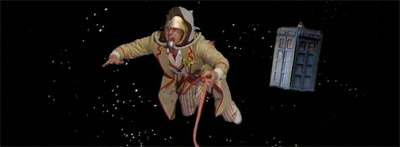



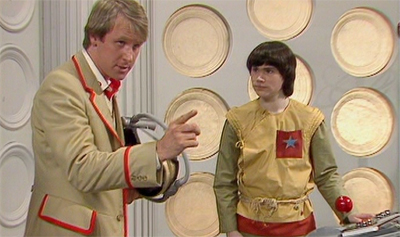
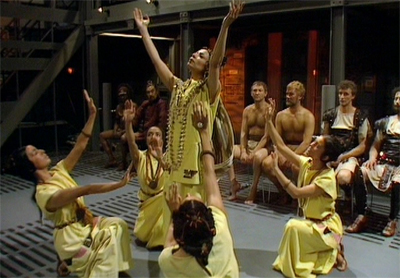




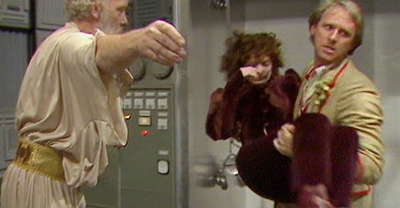
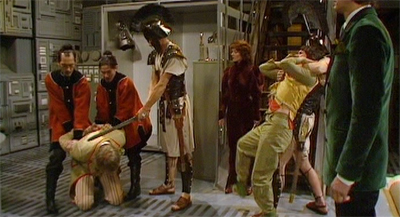


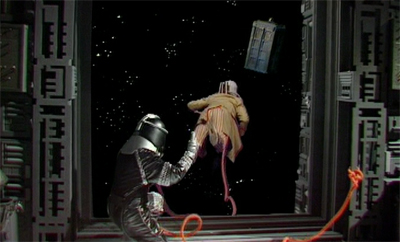
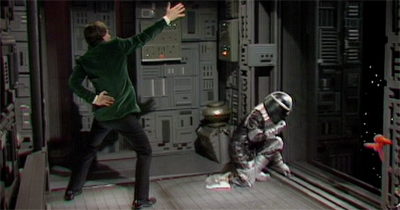






Reblogged this on queenofshebaformulary.
Thanks for the reblog!